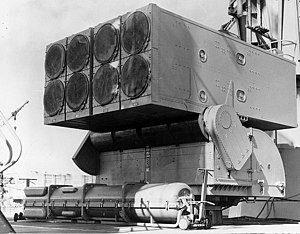| RUR-5 ASROC | |
|---|---|
 ASROC Launcher | |
| Type | Standoff Anti-Submarine |
| Place of origin | United States |
| Service history | |
| In service | @1963 |
| Used by | United States Navy and others |
| Production history | |
| Manufacturer | Honeywell |
| Unit cost | Approximately $350,000 (less torpedo payload) |
| Specifications | |
| Weight | 1407 lb (638 kg) |
| Length | 16 ft 0.6 in (4.892 m) |
| Diameter | 16.6 in (422 mm) |
| | |
| Warhead | Mark 46 torpedo, 100 lb (45 kg) of PBXN-103 high explosive |
| Detonation mechanism | Payload Specific |
| | |
| Engine | Solid propellant rocket motor |
| Wingspan | 26 7/8 in (683 mm) |
| Operational range | 15 nm (28 km) |
| Speed | Subsonic |
| Guidance system | Inertial Guidance |
| Launch platform | Surface Ship |
ASROC (for Anti-Submarine ROCket) is an, all-weather, all sea-conditions anti-submarine missile system, developed by the United States Navy in the 1950s, deployed in the 1960s, updated in the 1990s and eventually installed on over 200 USN surface ships, specifically cruisers, destroyers, and frigates, such as the Knox-class. The ASROC was/is also deployed on scores of warships of many other navies, including Australia, Canada, Germany, Italy, Japan, the Republic of China, Greece, and others.[1]
Contents[hide] |
[edit] Description
A surface ship, patrol plane, or anti-submarine helicopter first detects an enemy submarine by using sonar and/or other sensors, relaying the range and bearing information to the attacking ship which then fires an ASROC missile onto an unguided ballistic trajectory, carrying an acoustic homing torpedo or, formerly a Nuclear Depth Bomb (NDB) toward the target. At a pre-determined position on the missile's trajectory the payload separates from the missile and deploys a parachute to slow the torpedo to permit splashdown and water entry at a low speed and minimum detectable noise. The water entry activates the torpedo, and guided by its own sonar system, it homes in on the target using either active sonar or passive sonar. When the missile hypothetically carried a nuclear weapon, the unguided NDB, sinks quickly to a predetermined depth and detonated. Note - the nuclear-armed ASROC was never used for any purpose, except for one or two tests in 1961-62. Then the Limited Nuclear Test Ban Treaty banning underwater nuclear tests went into effect. The nuclear weapon was never used in combat. An ASROC missile could hypothetically carry a 10 kiloton W44 nuclear warhead, although the W44-armed nuclear weapon were ordered to be retired by 1989, and all types of nuclear depth bombs were removed from deployment. [1]

The first ASROC system (RUR-5), using the MK-112 "Matchbox" launcher, was developed in the 1950s and installed in the 1960s. This system was phased out in the 1990s and replaced with the RUM-139 Vertical Launch ASROC, or "VLA".[1]
[edit] RUM-139 ASROC
The VLS-ASROC missile is a rocket-propelled, three-stage, anti-submarine warfare (ASW) weapon designed for deployment on Ticonderoga-class cruisers, Arleigh Burke-class destroyers, and formerly on the Spruance-class destroyers that were equipped with the Mark-41 Vertical Launching System (VLS). Note that all of the Spruance-class destroyers have now been retired from service. Also, several other navies use or plan to use the MK-41 VLS, capable of carrying the VLS-ASROC, including those of Australia, Canada, Japan, Spain, Norway, South Korea, and others. For more information, see a standard naval reference such as Jane's Fighting Ships.
The VLS-ASROC missile provides the navies with the capability for rapid response, all weather delivery of an MK-46 torpedo against threat submarines in any direction at intermediate ranges. VLS-ASROC missiles were introduced into the fleet in 1993 as a new weapon for the cruisers and destroyers equipped with the Aegis combat system, and as a replacement for the ASROC weapon on the Spruance-class destroyers when their original ASROC launchers were replaced by the MK-41 VLS.
[edit] Spruance Class Installation
The 31-Spruance-class destroyers initially all had an interesting, Mk 112, ASROC reload system. They had one standard Mk 16 octuple launcher, but this was adjacent to a deckhouse which held 16 reload missiles. Thus, each Spruance-class originally carried a grand total of 24 ASROC.[2] Most other destroyers, destroyer escorts, and frigates only carried the one launcher with, up to, 8 ASROC missiles, as some of those missiles could be replaced by the Boeing Harpoon anti-ship missile. The "matchbook" Mk 16 launchers were capable of carrying a mixture of the two types. Most Spruance-class destroyers were later modified to include the MK-41 VLS, these launchers are capable of carrying a mixture of the VLS-ASROC, the Tomahawk TLAM, and other missiles. All of the Spruance destroyers carried two separate quad Harpoon launchers.
VLS-ASROC missiles were first introduced with the MK-46 torpedo as its payload. In 1996 an upgrade was implemented to allow the enhanced shallow-water capable MK-46 to be included as the VLS-ASROC missile payload (RUM139B). VLS-ASROC missiles are delivered to the fleet as All-Up-Rounds (AURs) which consist of the ASROC missile installed inside of an MK-41 VLS canister. VLS-ASROC missiles have two basic fleet configurations, warshot and exercise.



1 comment:
smart outsourcing solutions is the best outsourcing training
in Dhaka, if you start outsourcing please
visit us: It training institute in dhaka
Post a Comment